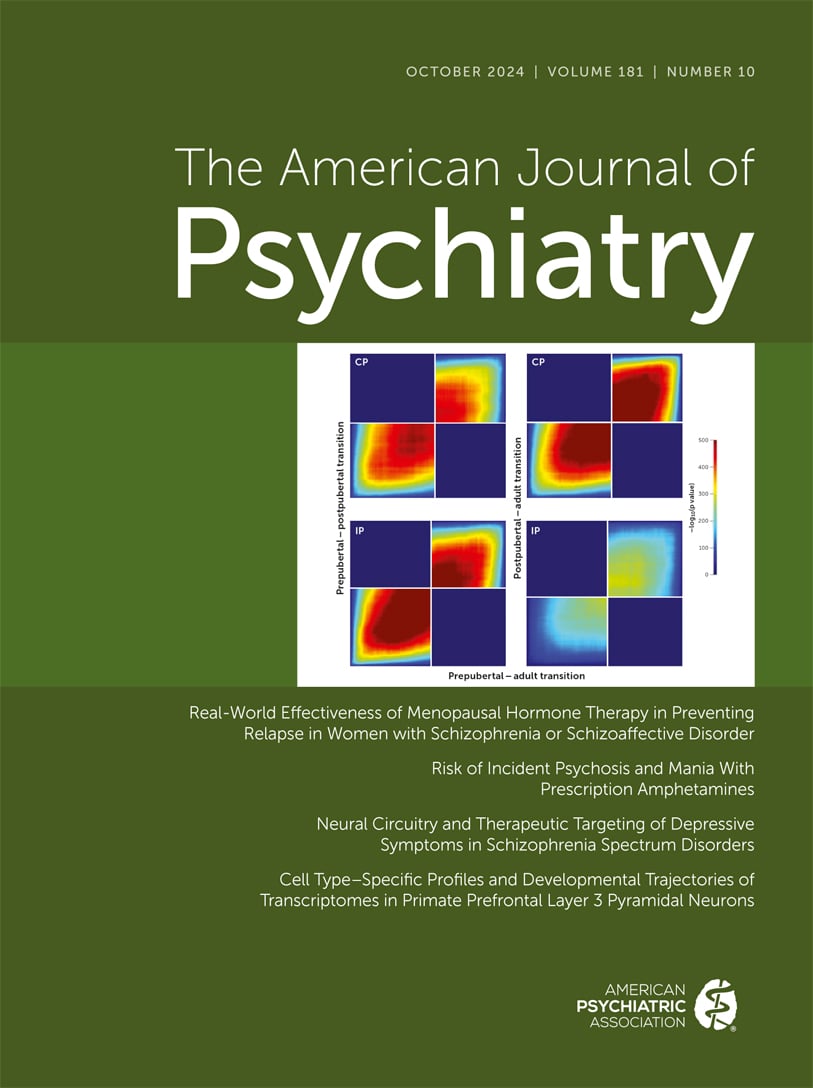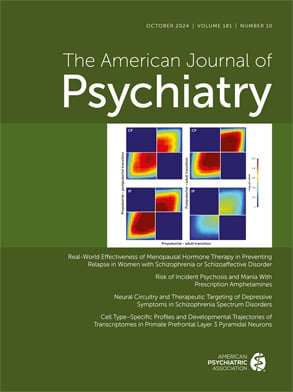Following medication approvals, uncommon or rare adverse drug events (ADEs) are tracked by pharmacovigilance databases and/or national or international registries (
1,
2), and may increasingly appear in social media, which may sometimes provide misinformation. Pharmacovigilance data are well-known to be underreported and often inadequate to provide patients and health care professionals the kind of knowledge needed to undertake important health care decisions. One example of uncommon adverse events were neuropsychiatric adverse events associated with varenicline, for which the U.S. Food and Drug Administration (FDA) had issued a black box warning; a multinational randomized smoking cessation clinical trial in over 8,000 individuals (half of whom had psychiatric disorders) was required to undo the black box warning and to affirm the safety of the three FDA-approved smoking cessation aids (
3). Another important data source for uncommon ADEs are the national health care registries maintained in some countries, where decades’ worth of medication and associated health outcomes data are available for study.
In this issue, Partanen and colleagues (
4) present ADE data from a 25-year follow-up of a Finnish registry, from 2,659 individuals with schizophrenia receiving clozapine for a median follow-up of 12.7 years, representing nearly a third of all clozapine users in Finland. Across 2,157 disease and health-related events, 27 events representing five categories were enriched among clozapine users, namely, gastrointestinal hypomotility, seizures, pneumonia, other respiratory infections, and tachycardia. Among other enriched events were neutropenia, type 2 diabetes, fever, and bacterial infections. Aside from intestinal infections, all other ADEs have been reported previously with clozapine use. For cumulative incidence estimates, the researchers had access to a clozapine-only treatment group, an olanzapine-only group, a group that had received neither clozapine nor olanzapine, and a fourth group without schizophrenia who had not received either medication.
A wealth of information has emerged from this data set, as noted in the text, tables, figures, and supplementary materials. Some points that merit emphasis for clinical practice include higher risks for women for constipation, acute upper respiratory and intestinal infections, and type 2 diabetes; an increased risk of drug-induced seizures and type 2 diabetes with age; and an association between higher clozapine dosage and nearly all but three reported ADEs. Recurrence rates were high for constipation (57.1%, more than one event) followed by pneumonia, seizures, and ileus. Cumulative incidence rates of ADEs at ages 30, 50, and 70 clearly separated the clozapine-only group from the olanzapine-only group or the other two comparator groups, in that the clozapine-only group had the highest cumulative incidences of all 14 enriched ADEs among patients with schizophrenia. By age 50, just over 25% of the clozapine users had experienced pneumonia, constipation, and type 2 diabetes, and over 50% had received antiepileptics or beta-blockers (the latter medication class served as a proxy for tachycardia), and these cumulative incidences rose for the five ADEs at age 70 to between 54.5% and 76.5%.
In terms of timing of ADEs following clozapine initiation, neutropenia, fever, bacterial infections, use of beta-blockers, and use of antiepileptics occurred more commonly (within weeks to months); pneumonia, constipation, and epilepsy occurred less frequently (<15% by 6 months), and ileus and type 2 diabetes even less frequently (<5% by 6 months). Unsurprisingly, clozapine discontinuations occurred for drug-induced neutropenia (within days) with an odds ratio of nearly 12, and epilepsy with an odds ratio of 2.4. There were 61 deaths among the clozapine users, with 12 deaths among 79 ileus-diagnosed patients (odds ratio=4.5) and 24 deaths among 408 patients with pneumonia (odds ratio=2.8). The overall numbers of deaths are fewer than expected, likely due to the use of data of a more recent registry in Finland (SUPER-Finland; recruited 2015–2018), constituting about 10% of the Finnish population with schizophrenia.
The authors computed the attributable risk proportion, that is, the risk directly attributed to clozapine usage, and the exposure impact number, or the number of clozapine users for whom one excess event case arises due to clozapine use (not unlike the number needed to harm). The attributable risk proportion was high for most enriched events among clozapine users (0.34–0.65), lower for type 2 diabetes (0.15), and very high for drug-induced seizures (0.88). In terms of the exposure impact number, it is important to remember that the lower the number, the higher the risk. The exposure impact number was the highest for drug-induced seizures (91.9), followed by drug-induced neutropenia (67.1), ileus (43.1), constipation (12.8), and pneumonia (11.8). Moreover, even though clozapine is indicated for treatment-resistant schizophrenia, it is difficult to control for treatment-resistant disease–related confounders in a registry study.
The authors used the genotype activity of the genes involved in clozapine metabolism in a rule-based phenotype and activity prediction (poor to ultrarapid), via Stargazer, a publicly available bioinformatics tool. However, this is not a model that permits dynamic predictions modifiable by interactions, such as drug-drug interactions or infections/inflammation, and so on, which would be more useful for real-time decision making by frontline clinicians. The analyses indicated that the incidence of pneumonia was 15% in CYP2C19 ultrarapid metabolizers and nearly double at 28.6% in poor metabolizers. Decreased CYP1A2 activity (infrequently seen, at 0.43%) was associated with a pneumonia incidence of 45.5%, but of 19.1% when CYP1A2 activity was highly inducible. While the results are intriguing, more work is needed for direct clinic translation.
In the study, hematological monitoring proved effective, as clozapine was quickly discontinued when severe neutropenia/agranulocytosis was detected, and these accounted for fewer than five deaths among clozapine users in this longitudinal study. Yet, what can we do about the multi-fold
much higher life-threatening clozapine-associated ADEs that occur with the complications of severe constipation (bowel obstruction, ileus, perforation, etc.) and pneumonia compared to agranulocytosis? (
5–
8).
Clozapine’s strongly antimuscarinic and antihistaminergic effects are well known, but its impact on gastrointestinal hypomotility is significant and needs greater awareness. One study illustrates gastrointestinal hypomotility dramatically, with median colonic transit time measured by monitoring the movement of gelatin capsules with radiopaque markers with a series of abdominal X-rays being fourfold higher, at nearly 105 hours for clozapine compared with 23 hours for non-clozapine antipsychotic drugs, contributing to life-threatening ADEs (
9). Educating patients, caregivers, and health care professionals on adequate hydration, overcoming sedation and immobility, exercise, and diet is good practice but not adequate. Neither is screening for constipation in isolation, as clozapine users often may not complain of constipation until severe symptoms occur (
10). Moreover, unlike clozapine-associated neutropenia, the “all too common constipation” may not get the same level of attention by caregivers and health care professionals until severe medical complications occur. Clozapine-treated patients require medical vigilance for bowel complaints—for example, abdominal pain lasting an hour or more, abdominal distension, vomiting (especially feculent)—and fever and instability of vital signs, which are indicative of emergency hospitalization and may require life-saving surgery.
Polypharmacy is common with clozapine-treated patients, and optimizing the pharmacological regimen by tapering and stopping other anticholinergic medications (e.g., benztropine, trihexyphenidyl) or trying to switch anticholinergic overactive bladder medications (e.g., oxybutynin) for beta-3 agonists (e.g., mirabegron), or stopping the use of regular antihistamines (diphenhydramine or hydroxyzine), or scopolamine patches for nausea, or on- or off-label uses of anticholinergic antidepressants like amitriptyline or doxepin for pain or insomnia, is within the prescriber’s purview (
11). Anticholinergic medication burden data were unavailable in the Finland study.
An aggressive bowel regimen should be standard, starting with stool softeners and stimulant laxatives, and with a low threshold for moving to osmotic laxatives rather quickly, and then treating refractory cases with intestinal secretagogues (
12,
13). It is pertinent for clinicians to remember
not to use bulk-forming (fiber) laxatives (and contrary to popular belief, excess fiber in the diet may also be problematic) in gastrointestinal hypomotility, as inspissation and worsening constipation could result. Having an inter-professional team involved (psychiatrists, nurses, pharmacists, GI specialists, and others) can help practically implement these recommendations and improve gastrointestinal hypomotility care with regular bowel movement monitoring (
14).
Pneumonia is another life-threatening clozapine-associated ADE, and the data presented by Partanen et al. affirm prior findings. In an analysis of VigiBase data (
6), pneumonia was found to be the most common cause of death among patients treated with clozapine. Clozapine has been associated with hypersensitivity pneumonia during titration and aspiration pneumonia due to hypersalivation and sedation, but infective pneumonia may factor in too, as the Finnish study could not distinguish the type of pneumonia. Preventive approaches are required, and clinicians should regularly monitor for signs and symptoms of infection, such as fever, chills, sweating, cough, breathing troubles, rapid pulse, and, if available, pulse oximetry and encourage patients, families, and caregivers to seek medical attention urgently. Clinicians should address two potentially modifiable risk factors that are more common among people with schizophrenia: cigarette smoking and obesity. This can be achieved through smoking cessation and employing lifestyle and possibly pharmacological interventions for weight loss. It is important to remember that decreasing or ceasing cigarette smoking in acute infections can elevate clozapine levels to toxicity, and therefore a temporary downward dosage adjustment of clozapine by 50% or even discontinuation may be required. To reduce the risk of community-acquired pneumonia among clozapine users, health care professionals should promote vaccinations such as influenza, pneumonia, COVID-19, and RSV vaccines. Managing sedation and sialorrhea assertively could be strategies to reduce the aspiration risk for clozapine-treated patients. Higher clozapine levels confer increased risk for most ADEs, and thus maintaining clozapine at the lowest effective dosage would be prudent.
Partanen and colleagues make a compelling case that gastrointestinal hypomotility and pneumonia deserve the same careful attention that we pay to hematologic monitoring in clozapine users. Complications such as ileus and pneumonia tend to recur and increase over time and with age in clozapine users, demanding long-term monitoring and management. Educational efforts are needed to continue to reinforce these points. Resources for evidence-based practice of gastrointestinal hypomotility management, pneumonia prevention, and mitigation of other clozapine ADEs are essential and need to be widely available and regularly updated at professionally maintained online sites. Absent a more efficacious and safer alternative to clozapine for treatment-resistant schizophrenia, it is imperative that we remain vigilant and proactively manage these life-threatening ADEs.

